 W
WThe alkali–silica reaction (ASR), more commonly known as "concrete cancer", is a deleterious swelling reaction that occurs over time in concrete between the highly alkaline cement paste and the reactive amorphous silica found in many common aggregates, given sufficient moisture.
 W
WArtificial stone is a name for various synthetic stone products produced from the 18th century onward. Uses include statuary, architectural details, fencing and rails, building construction, civil engineering work, and industrial applications such as grindstones.
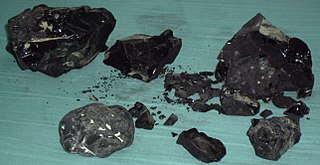 W
WAsphalt, also known as bitumen, is a sticky, black, highly viscous liquid or semi-solid form of petroleum. It may be found in natural deposits or may be a refined product, and is classed as a pitch. Before the 20th century, the term asphaltum was also used. The word is derived from the Ancient Greek ἄσφαλτος ásphaltos. The largest natural deposit of asphalt in the world, estimated to contain 10 million tons, is the Pitch Lake located in La Brea in southwest Trinidad, within the Siparia Regional Corporation.
 W
WAsphalt concrete is a composite material commonly used to surface roads, parking lots, airports, and the core of embankment dams. Asphalt mixtures have been used in pavement construction since the beginning of the twentieth century. It consists of mineral aggregate bound together with asphalt, laid in layers, and compacted. The process was refined and enhanced by Belgian-American inventor Edward De Smedt.
 W
WBlock paving also known as brick paving is a commonly used decorative method of creating a pavement or hardstanding. The main benefit of bricks over other materials is that individual bricks can later be lifted up and replaced. This allows for remedial work to be carried out under the surface of the paving without leaving a lasting mark once the paving bricks have been replaced. Typical areas of use would be for driveways, pavement, patios, town centres, pedestrian precincts and more commonly in road surfacing. Bricks are typically made of concrete or clay, though other composite materials are also used. Each has its own means of construction. The biggest difference is the way they set hard ready for use. A clay brick has to be fired in a kiln to bake the brick hard. A concrete brick has to be allowed to set. The concrete paving bricks are a porous form of brick formed by mixing small stone hardcore, dyes, cement and sand and other materials in various amounts. Many block paving manufacturing methods are now allowing the use of recycled materials in the construction of the paving bricks such as crushed glass and crushed old building rubble.
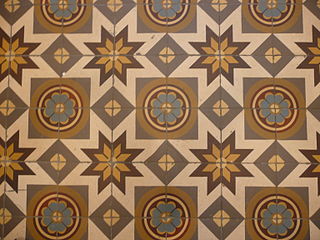 W
WCement tiles or hydraulic tiles are handmade colourful tiles used as floor and wall tiling. They appeared in Catalonia (Spain) in the 1850s, and have been widely used in Europe and America. Another origin I from Viviers, south of France. They represented a revolution in flooring in their day because they were much cheaper, more durable and easier to make than the previous handmade glazed ceramic tiles and were therefore more universally available for houses, and they allowed for profuse decorative patterns, their age of splendour being the end of the 19th to the middle of the 20th centuries, before they were gradually superseded by newer technologies as of the 1960s, such as terrazzo, salt-glazed stoneware, etc. that did not allow for such decorative embellishment but were cheaper.
 W
WChipseal is a pavement surface treatment that combines one or more layer(s) of asphalt with one or more layer(s) of fine aggregate. In the United States, chipseals are typically used on rural roads carrying lower traffic volumes, and the process is often referred to as asphaltic surface treatment. This type of surface has a variety of other names including tar-seal or tarseal, tar and chip, sprayed seal or surface dressing.
 W
WCobblestone is a natural building material based on cobble-sized stones, and is used for pavement roads, streets, and buildings.
 W
WConcrete is a composite material composed of fine and coarse aggregate bonded together with a fluid cement that hardens (cures) over time. Concrete is the second-most-used substance in the world after water, and is the most widely used building material. Its usage worldwide, ton for ton, is twice that of steel, wood, plastics, and aluminum combined. Globally, the ready-mix concrete industry, the largest segment of the concrete market, is projected to exceed $600 billion in revenue by 2025. This widespread use results in a number of environmental impacts. Most notably, the production process for cement produces large volumes of greenhouse gas emissions, leading to net 8% of global emissions. Other environmental concerns include widespread illegal sand mining, impacts on the surrounding environment such as increased surface runoff or urban heat island effect, and potential public health implications from toxic ingredients. Significant research and development is being done to try to reduce the emissions or make concrete a source of carbon sequestration, and increase recycled and secondary raw materials content into the mix to achieve a circular economy. Concrete is expected to be a key material for structures resilient to climate disasters, as well as a solution to mitigate the pollution of other industries, capturing wastes such as coal fly ash or bauxite tailings and residue.
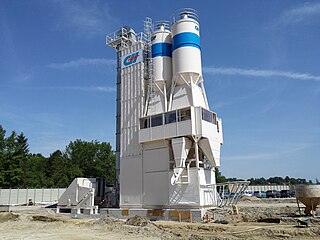 W
WA concrete mixer is a device that homogeneously combines cement, aggregate such as sand or gravel, and water to form concrete. A typical concrete mixer uses a revolving drum to mix the components. For smaller volume works, portable concrete mixers are often used so that the concrete can be made at the construction site, giving the workers ample time to use the concrete before it hardens. An alternative to a machine is mixing concrete by hand. This is usually done in a wheelbarrow; however, several companies have recently begun to sell modified tarps for this purpose.
 W
WConstruction aggregate, or simply aggregate, is a broad category of coarse- to medium-grained particulate material used in construction, including sand, gravel, crushed stone, slag, recycled concrete and geosynthetic aggregates. Aggregates are the most mined materials in the world. Aggregates are a component of composite materials such as concrete and asphalt; the aggregate serves as reinforcement to add strength to the overall composite material. Due to the relatively high hydraulic conductivity value as compared to most soils, aggregates are widely used in drainage applications such as foundation and French drains, septic drain fields, retaining wall drains, and roadside edge drains. Aggregates are also used as base material under foundations, roads, and railroads. In other words, aggregates are used as a stable foundation or road/rail base with predictable, uniform properties, or as a low-cost extender that binds with more expensive cement or asphalt to form concrete.
 W
WCool pavement is a road surface that uses additives to reflect solar radiation unlike conventional dark pavement. Conventional dark pavements contribute to urban heat islands as they absorb 80–95% of sunlight and warm the local air. Cool pavements are made with different materials to increase albedo, thereby reflecting shortwave radiation out of the atmosphere. Increasing albedo reduces heat transfer to the surface and can hypothetically cause local cooling if the spatial scale of the albedo reduction is sufficiently large. The EPA reports "that if pavement reflectance throughout a city were increased from 10 to 35 percent, the air temperature could potentially be reduced by 1°F (0.6°C)." Existing dark pavement can be altered to increase albedo through whitetopping or by adding reflective coats and seals. New pavement can be constructed to increase albedo by using modified mixes, permeable pavements, and vegetated pavements.
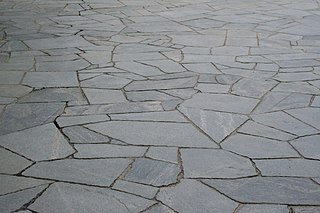 W
WCrazy paving is a means of hard-surfacing used outdoors, most frequently in gardens. Paving stones of irregular size and shape are laid in a haphazard manner sometimes with mortar filling the gaps between.
 W
WCrumb rubber is recycled rubber produced from automotive and truck scrap tires. During the recycling process, steel and tire cord (fluff) are removed, leaving tire rubber with a granular consistency. Continued processing with a granulator or cracker mill, possibly with the aid of cryogenics or by mechanical means, reduces the size of the particles further. The particles are sized and classified based on various criteria including color. The granulate is sized by passing through a screen, the size based on a dimension or mesh. Crumb rubber is often used in artificial turf as cushioning.
 W
WCrushed stone or angular rock is a form of construction aggregate, typically produced by mining a suitable rock deposit and breaking the removed rock down to the desired size using crushers. It is distinct from gravel which is produced by natural processes of weathering and erosion, and typically has a more rounded shape.
 W
WDecomposed granite is classification of rock that is derived from granite via its weathering to the point that the parent material readily fractures into smaller pieces of weaker rock. Further weathering yields material that easily crumbles into mixtures of gravel-sized particles known as grus, that further may break down to produce a mixture of clay and silica sand or silt particles. Different specific granite types have differing propensities to weather, and so differing likelihoods of producing decomposed granite. It has practical uses that include its incorporation into paving and driveway materials, residential gardening materials in arid environments, as well as various types of walkways and heavy-use paths in parks. Different colors of decomposed granite are available, deriving from the natural range of granite colors from different quarry sources, and admixture of other natural and synthetic materials can extend the range of decomposed granite properties.
 W
WDimension stone is natural stone or rock that has been selected and finished to specific sizes or shapes. Color, texture and pattern, and surface finish of the stone are also normal requirements. Another important selection criterion is durability: the time measure of the ability of dimension stone to endure and to maintain its essential and distinctive characteristics of strength, resistance to decay, and appearance.
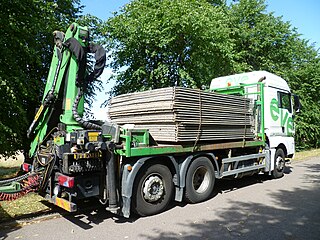 W
WEve Trakway are a supplier of temporary access systems. The firm is the principal trading subsidiary of Accession Group Limited, which in 2013 was acquired by Ashtead Group plc for cash of £28 million, and a £7 million earnout.
 W
WFlagstone (flag) is a generic flat stone, sometimes cut in regular rectangular or square shape and usually used for paving slabs or walkways, patios, flooring, fences and roofing. It may be used for memorials, headstones, facades and other construction. The name derives from Middle English flagge meaning turf, perhaps from Old Norse flaga meaning slab or chip.
 W
WA floor medallion is generally a centerpiece of flooring design that can be made with various flooring materials, including natural stone, wood, metal, tile, glass or a variety of other materials suitable for flooring. The pattern can be created using various methods such as mosaic, intarsia, and marquetry.
 W
WFull depth recycling or full depth reclamation (FDR) is a process that rebuilds worn out asphalt pavements by recycling the existing roadway.
 W
WGranular base equivalency or granular base equivalence (GBE) is a measure of total pavement thickness. Since pavement is composed of multiple layers with different physical properties, its total thickness is measured by GBE. GBE translates the thickness of different road layers to a number using a set of coefficients. So, to calculate the GBE, the depth of each layer should be multiplied by the granular equivalency factor for the material in that layer. In the next step the sum of the converted layer thicknesses is calculated. This sum is called granular base equivalency, which is a popular and important measure in pavement design and pavement performance modeling.
 W
WA grating is any regularly spaced collection of essentially identical, parallel, elongated elements. Gratings usually consist of a single set of elongated elements, but can consist of two sets, in which case the second set is usually perpendicular to the first. When the two sets are perpendicular, this is also known as a grid or a mesh.
 W
WGravel is a loose aggregation of rock fragments. Gravel is classified by particle size range and includes size classes from granule- to boulder-sized fragments. In the Udden-Wentworth scale gravel is categorized into granular gravel and pebble gravel. ISO 14688 grades gravels as fine, medium, and coarse, with ranges 2–6.3 mm to 20–63 mm. One cubic metre of gravel typically weighs about 1,800 kg.
 W
WHardscape refers to hard landscape materials in the built environment structures that are incorporated into a landscape. This can include paved areas, driveways, retaining walls, sleeper walls, stairs, walkways, and any other landscaping made up of hard wearing materials such as wood, stone, and concrete, as opposed to softscape, the horticultural elements of a landscape.
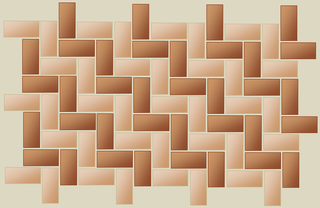 W
WThe herringbone pattern is an arrangement of rectangles used for floor tilings and road pavement, so named for a fancied resemblance to the bones of a fish such as a herring.
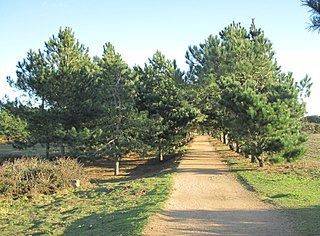 W
WHoggin is a compactable groundcover that is composed of a mixture of clay, gravel, and sand or granite dust that produces a buff-coloured bound surface. It is more commonly seen in the south of England and at National Trust properties. The material is aesthetically suited to older properties and is lower maintenance than gravel alone since it does not need regular raking. Once laid, the surface is somewhat permeable to water and therefore does not easily hold puddles or generate rapid surface runoff. The material is increasingly being used at domestic properties as a low cost and environmentally friendly alternative to concrete and block paving in paths and driveways.
 W
WLong-Term Pavement Performance Program, known as LTPP, is a research project supported by Federal Highway Administration (FHWA) to collect and analyze pavement data in the United States and Canada. Currently, the LTPP acquires the largest road performance database.
 W
WA mosaic is a pattern or image made of small regular or irregular pieces of colored stone, glass or ceramic, held in place by plaster/mortar, and covering a surface. Mosaics are often used as floor and wall decoration, and were particularly popular in the Ancient Roman world.
 W
WNicolson pavement, alternatively spelled "Nicholson" and denominated wooden block pavement and wood block pavement, is a road surface material consisting of wooden blocks. Samuel Nicolson invented it in the mid-19th century. Wooden block pavement has since become unfavored because of its poor surface quality and high cost of maintenance.
 W
WOpus spicatum, literally "spiked work," is a type of masonry construction used in Roman and medieval times. It consists of bricks, tiles or cut stone laid in a herringbone pattern.
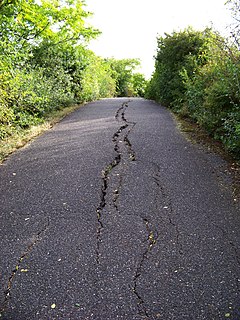 W
WPavement crack refers to a variety of types of pavement distresses that occur on the surface of pavements. Different types of pavements develop different cracks. Type of cracking is also correlated with the type of climate and traffic. Sometimes the cracks are aggregated using an index such as Crack Index, and sometimes they are merged with other distresses and are reported using Pavement Condition Index.
 W
WPavement performance modeling or pavement deterioration modeling is the study of pavement deterioration throughout its life-cycle. The health of pavement is assessed using different performance indicators. Some of the most well-known performance indicators are Pavement Condition Index (PCI), International Roughness Index (IRI) and Present Serviceability Index (PSI), but sometimes a single distress such as rutting or the extent of crack is used. Among the most frequently used methods for pavement performance modeling are mechanistic models, mechanistic-empirical models, survival curves and Markov models. Recently, machine learning algorithms have been used for this purpose as well. Most studies on pavement performance modeling are based on IRI.
 W
WA paver is a piece of construction equipment used to lay asphalt on roads, bridges, parking lots and other such places. It lays the asphalt flat and provides minor compaction before it is compacted by a roller.
 W
WPermeable paving surfaces are made of either a porous material that enables stormwater to flow through it or nonporous blocks spaced so that water can flow between the gaps. Permeable paving can also include a variety of surfacing techniques for roads, parking lots, and pedestrian walkways. Permeable pavement surfaces may be composed of; pervious concrete, porous asphalt, paving stones, or interlocking pavers. Unlike traditional impervious paving materials such as concrete and asphalt, permeable paving systems allow stormwater to percolate and infiltrate through the pavement and into the aggregate layers and/or soil below. In addition to reducing surface runoff, permeable paving systems can trap suspended solids, thereby filtering pollutants from stormwater.
 W
WPietra dura or pietre dure, called parchin kari or parchinkari in the Indian Subcontinent, is a term for the inlay technique of using cut and fitted, highly polished colored stones to create images. It is considered a decorative art. The stonework, after the work is assembled loosely, is glued stone-by-stone to a substrate after having previously been "sliced and cut in different shape sections; and then assembled together so precisely that the contact between each section was practically invisible". Stability was achieved by grooving the undersides of the stones so that they interlocked, rather like a jigsaw puzzle, with everything held tautly in place by an encircling 'frame'. Many different colored stones, particularly marbles, were used, along with semiprecious, and even precious stones. It first appeared in Rome in the 16th century, reaching its full maturity in Florence. Pietra dura items are generally crafted on green, white or black marble base stones. Typically, the resulting panel is completely flat, but some examples where the image is in low relief were made, taking the work more into the area of hardstone carving.
 W
WPortuguese pavement, known in Portuguese as calçada portuguesa or simply calçada is a traditional-style pavement used for many pedestrian areas in Portugal. It consists of small flat pieces of stones arranged in a pattern or image, like a mosaic. It can also be found in Olivença and throughout former Portuguese colonies. Portuguese workers are also hired for their skill in creating these pavements in places such as Gibraltar. Being usually used in sidewalks, it is in town squares and atriums that this art finds its deepest expression.
 W
WR.S. Blome Granitoid Pavement is a historic road surface, as well as the associated cut sandstone curbs in a few sections, found in three of the oldest residential sections of Grand Forks, North Dakota. It is a Portland cement–aggregate combination that was intended to bridge the gap between the needs of Horse-drawn vehicles, which required sure footing, and automobiles, which needed a hard, resilient surface, in the earliest part of the 20th century.
 W
WA road surface, or pavement, is the durable surface material laid down on an area intended to sustain vehicular or foot traffic, such as a road or walkway. In the past, gravel road surfaces, cobblestone and granite setts were extensively used, but these have mostly been replaced by asphalt or concrete laid on a compacted base course. Asphalt mixtures have been used in pavement construction since the beginning of the 20th century and are of two types: metalled roads and unmetalled roads. Metalled roadways are made to sustain vehicular load and so are usually made on frequently-used roads. Unmetalled roads, also known as gravel roads, are rough and can sustain less weight. Road surfaces are frequently marked to guide traffic.
 W
WA road is a thoroughfare, route, or way on land between two places that has been surfaced or otherwise improved to allow travel by foot or some form of conveyance, including a motor vehicle, cart, bicycle, or horse. Roads have been adapted to a large range of structures and types in order to achieve a common goal of transportation under a large and wide range of conditions. The specific purpose, mode of transport, material and location of a road determine the characteristics it must have in order to maximize its usefulness. Following is one classification scheme.
 W
WRoman concrete, also called opus caementicium, was a material used in construction in Ancient Rome. Roman concrete was based on a hydraulic-setting cement. It is durable due to its incorporation of pozzolanic ash, which prevents cracks from spreading. By the middle of the 1st century, the material was used frequently, often brick-faced, although variations in aggregate allowed different arrangements of materials. Further innovative developments in the material, called the concrete revolution, contributed to structurally complicated forms, such as the Pantheon dome, the world's largest and oldest unreinforced concrete dome.
 W
WSaltillo tile is a type of terracotta tile that originates in Saltillo, Coahuila, Mexico. It is one of the two most famous products of the city, the other being multi-coloured woven sarapes so typical of the region. Saltillo-type tiles are now manufactured at many places in Mexico, and high-fire "Saltillo look" tiles, many from Italy, compete with the terracotta originals.
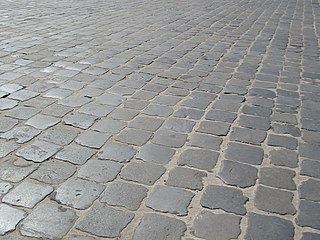 W
WSampietrini is the typical kind of pavement found in the historic district of Rome and in St. Peter's Square, Vatican City. The earliest examples were made by trimming large blocks that had been used in ancient Roman roads, recently discovered in fifteenth- and sixteenth-century archaeological excavations. The first documented use in Rome of "sampietrini" stones was during the reign of Pope Pius V (1566-72). Over the next two centuries the stones were used to pave all the main streets of Rome, because this mode was superior to brick, for example by providing a smoother and stronger surface for carriages, among other reasons.
 W
WScreed has three meanings in building construction:A flat board or a purpose-made aluminium tool used to smooth and to "true" materials like concrete, stucco and plaster after they have been placed on a surface or to assist in flattening; A strip of plaster or wood applied to a surface to act as a guide for a screed tool ; The material itself which has been flattened with a screed. In the UK, screed has also come to describe a thin, top layer of material, poured in situ on top of the structural concrete or insulation, on top of which other finishing materials can be applied, or the structural material can be left bare to achieve a raw effect.
 W
WSealcoating, or pavement sealing, is the process of applying a protective coating to asphalt-based pavements to provide a layer of protection from the elements: water, oils, and U.V. damage.
 W
WA sett, also known as a block or Belgian block, is a broadly rectangular quarried stone used in paving roads and walkways. Formerly in widespread use, particularly on steeper streets because setts provided horses' hooves with better grip than a smooth surface, they are now encountered rather as decorative stone paving in landscape architecture. Setts are often referred to as "cobblestones", although a sett is distinct from a cobblestone in that it is quarried or worked to a regular shape, whereas the latter is generally a small, naturally-rounded rock. Setts are usually made of granite.
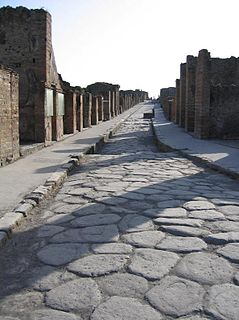 W
WA sidewalk, pavement, footpath, or footway, is a path along the side of a road. Usually constructed of concrete or asphalt, it is designed for pedestrians. A sidewalk may accommodate moderate changes in grade (height) and is normally separated from the vehicular section by a curb. There may also be a median strip or road verge either between the sidewalk and the roadway or between the sidewalk and the boundary.
 W
WSlate is a fine-grained, foliated, homogeneous metamorphic rock derived from an original shale-type sedimentary rock composed of clay or volcanic ash through low-grade regional metamorphism. It is the finest grained foliated metamorphic rock. Foliation may not correspond to the original sedimentary layering, but instead is in planes perpendicular to the direction of metamorphic compression.
 W
WStone mastic asphalt (SMA), also called stone-matrix asphalt, was developed in Germany in the 1960s with the first SMA pavements being placed in 1968 near Kiel. It provides a deformation-resistant, durable surfacing material, suitable for heavily trafficked roads. SMA has found use in Europe, Australia, the United States, and Canada as a durable asphalt surfacing option for residential streets and highways. SMA has a high coarse aggregate content that interlocks to form a stone skeleton that resists permanent deformation. The stone skeleton is filled with a mastic of bitumen and filler to which fibres are added to provide adequate stability of bitumen and to prevent drainage of binder during transport and placement. Typical SMA composition consists of 70−80% coarse aggregate, 8−12% filler, 6.0−7.0% binder, and 0.3 per cent fibre.
 W
WStructural Soil is a medium that can be compacted to pavement design and installation requirements while permitting root growth. It is a mixture of gap-graded gravels and soil. It provides an integrated, root penetrable, high strength pavement system that shifts design away from individual tree pits.
 W
WIn highway engineering, subbase is the layer of aggregate material laid on the subgrade, on which the base course layer is located. It may be omitted when there will be only foot traffic on the pavement, but it is necessary for surfaces used by vehicles.
 W
WIn transport engineering, subgrade is the native material underneath a constructed road, pavement or railway track. It is also called formation level.
 W
WThe tarmac scam is a confidence trick in which criminals sell fake or shoddy tarmac (asphalt) and driveway resurfacing. It is particularly common in Europe but practiced worldwide. Other names include tarmacking, the asphalt scam, driveway fraud or similar variants. Non-English names include "Truffa dell'asfalto" (Italian), "Teerkolonne" (German) and "les faux bitumeurs" (French).
 W
WTiles are usually thin, square or rectangular coverings manufactured from hard-wearing material such as ceramic, stone, metal, baked clay, or even glass. They are generally fixed in place in an array to cover roofs, floors, walls, edges, or other objects such as tabletops. Alternatively, tile can sometimes refer to similar units made from lightweight materials such as perlite, wood, and mineral wool, typically used for wall and ceiling applications. In another sense, a tile is a construction tile or similar object, such as rectangular counters used in playing games. The word is derived from the French word tuile, which is, in turn, from the Latin word tegula, meaning a roof tile composed of fired clay.
 W
WA tree grate is a metallic grating installed at the same level with the pavement around a tree that allows the soil underneath to stay uncompacted and the pedestrians to walk near the tree without stepping on the soil. Grate slots allow tree roots to absorb air, sunlight, and water, meanwhile its soil is protected from pedestrian traffic impact. Tree grates create a protective barrier, providing uncompacted soil and development space for tree roots. They also serve as a decorative element along ceremonial streets, matching a street's design style and personality.
 W
WIn American English, walkway is a composite or umbrella term for all engineered surfaces or structures which support the use of trails.